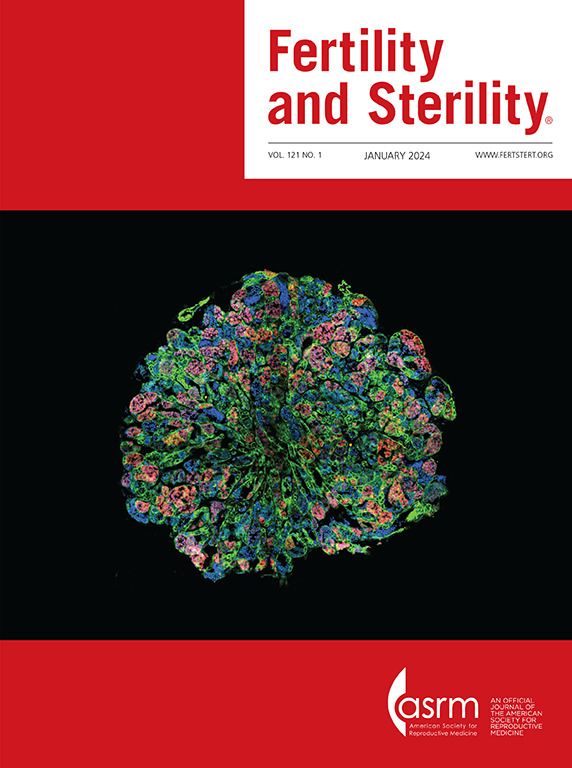节段性非整倍体人类胚胎早期发育延迟:多中心形态动力学分析。
IF 6.6
1区 医学
Q1 OBSTETRICS & GYNECOLOGY
引用次数: 0
摘要
目的:评估节段性非整倍体胚胎是否显示出独特的形态动力学模式:评估节段性非整倍体胚胎是否显示出独特的形态动力学模式 设计:回顾性多中心研究,包括 3 个欧洲试管婴儿中心在 2016 年至 2021 年间培养的共 7027 个胚胎。对多中心数据进行汇总分析,并对每个中心的数据分别进行分析。分析中考虑了染色体改变不超过4条的胚胎,结果显示有3040个优倍体、2818个全染色体和697个节段性非整倍体。总体而言,该数据集包含 3,742 对不同的单倍体-节段同胞:使用各种延时系统标注标准形态动力学特征。暴露:比较优倍体、全染色体非整倍体和节段非整倍体胚胎的形态运动模式:通过统计分析比较各组的形态发生时间,并评估与裂解特征的关联。对多中心和特定中心的多元逻辑回归模型进行校准,并使用Area-Under-ROC曲线指标对独立测试集数据的预测性能进行评估:结果:在前三个细胞周期中,节段性非整倍体胚胎的裂解速度明显慢于其同胞优倍体胚胎,并延迟到囊胚发育阶段。特别是在这些早期细胞周期中,节段非整倍体胚胎的发育速度也明显慢于其非整倍体同胞。一个基于多中心数据集形态动力学数据并与非整倍体类型回归的逻辑模型在独立测试集上显示出适度的预测性能(train-AUROC=0.58;test-AUROC=0.57)。基于单个中心的数据,预测性能有所提高,在来自同一中心的独立测试集上显示出足够的预测性能(训练-AUROC=0.74;测试-AUROC=0.64)。然而,在对其他中心的数据进行测试时,预测价值降低了(AUROC=0.52-0.55)。最后,多核和胚裂期胚泡排除与节段性非整倍体相关。将形态动力学特征和这些离散的胚胎形态特征结合到逻辑回归模型中(训练AUROC=0.71),可改善节段性非整倍体的预测,支持未来使用更全面的注释系统进行研究:所开发的预测框架可能有助于改善 PGT-A 周期的决策,帮助评估显示节段性非整倍体的胚胎,并区分哪些胚胎更有可能在移植时不会出现致死性均匀非整倍体。本文章由计算机程序翻译,如有差异,请以英文原文为准。
Human embryos with segmental aneuploidies display delayed early development: a multicenter morphokinetic analysis
Objective
To assess whether segmental aneuploid embryos display unique morphokinetic patterns.
Design
Retrospective multicenter study including a total of 7,027 embryos cultured between 2016 and 2021 in three European in vitro fertilization centers. Analysis was performed on aggregated multicenter data and separately for data from each center. Embryos with no more than four chromosomal alterations were considered in the analysis, resulting in 3,040 euploids and 2,818 whole-chromosome and 697 segmental aneuploids. Overall, the data set contained 3,742 distinct euploid-segmental sibling pairs.
Subjects
Standard morphokinetic features were annotated using various time-lapse systems. Blastocysts were subjected to comprehensive chromosomal screening via preimplantation genetic testing for aneuploidy.
Exposure
Morphokinetic patterns were compared among euploid, whole-chromosome aneuploid, and segmental aneuploid embryos.
Main Outcome Measures
Morphokinetic timings across groups were compared using statistical analysis, and associations with cleavage features were assessed. Multicenter and center-specific multivariate logistic regression models were calibrated, and their predictive performance was evaluated on independent test set data using area under the receiver operating characteristic curve (AUROC) metrics.
Results
Segmental aneuploid embryos cleaved significantly slower than their euploid siblings across the first three cell cycles, with a delay reaching the blastocyst-stage of development. Specifically during these early cell cycles, segmental aneuploid embryos were also shown to be significantly slower than their aneuploid siblings. A logistic model on the basis of morphokinetic data from the multicenter data set and regressed against type of aneuploidy displayed modest predictive performance on an independent test set (train-AUROC = 0.58; test-AUROC = 0.57). Predictive performance improved on the basis of data from a single center displaying adequate predictive performance on an independent test set from the same center (train-AUROC = 0.74; test-AUROC = 0.64). However, the predictive value diminished when tested on data from other centers (AUROC = 0.52–0.55). Finally, the presence of multinucleation and blastomere exclusion at the cleavage stage were associated with segmental aneuploidies. The combination of morphokinetic features and these discrete embryo morphological features into the logistic regression model (train-AUROC = 0.71) provided an improved prediction of segmental aneuploidy, supporting future investigations using more comprehensive annotation systems.
Conclusion
The developed predictive framework may help improve decision-making in preimplantation genetic testing for aneuploidy cycles, helping in the evaluation of embryos showing segmental aneuploidy and distinguishing which embryos are more likely to not have lethal uniform aneuploidies for transfer.
Embriones humanos con aneuploidías segmentarias muestran desarrollo temprano retrasado: Un análisis morfocinético multicéntrico
Objetivo
Evaluar si los embriones con aneuploidías segmentarias muestras patrones morfocinéticos únicos.
Diseño
Estudio multicéntrico retrospectivo que incluye un total de 7,027 embriones cultivados entre 2016 y 2021 en tres centros europeos de fecundación in vitro. El análisis se realizó sobre los datos multicéntricos agregados y por separado para los datos de cada centro. Embriones con no más de cuatro alteraciones cromosómicas fueron considerados en el análisis, resultando en 3,040 euploides y 2,818 aneuploides de cromosoma completo y 697 aneuploides segmentarios. En total, el conjunto de datos contenía 3,742 pares de hermanos euploides segmentarios distintos.
Sujetos
Las características morfocinéticas standard fueron anotadas usando distintos sistemas de lapso de tiempo. Los blastocistos fueron sometidos a cribado cromosómico integral a través de la prueba genética preimplantacional para aneuploidías.
Exposición
Los parámetros morfocinéticos fueron comparados entre embriones euploides, aneuploides de cromosoma completo y aneuploides segmentarios.
Principales medidas de resultados
Los tiempos morfocinéticos entre los grupos fueron comparados utilizando análisis estadístico, y se evaluaron asociaciones con características de clivaje. Se calibraron modelos multivariables de regresión logística multicéntricos y centro-específicos, y su rendimiento predictivo fue evaluado sobre datos del conjunto de pruebas independientes utilizando métricas de área bajo la curva de características de funcionamiento del receptor (AUROC).
Resultados
Los embriones con aneuploidías segmentarias clivaron significativamente más lento que sus hermanos euploides a lo largo de los tres primeros ciclos celulares, con una demora en alcanzar el estadío de desarrollo de blastocisto. Específicamente durante estos ciclos celulares tempranos, los embriones con aneuploidías segmentarias mostraron ser significativamente más lentos que sus hermanos aneuploides. Un modelo logístico basado en los datos morfocinéticos del conjunto de datos multicéntricos y regresivo del tipo de aneuploidía mostró un rendimiento predictivo modesto en un conjunto de datos independientes (train-AUROC=0.58; test-AUROC=0.57). El rendimiento predictivo mejoró sobre la base de datos de un único centro mostrando rendimiento predictivo adecuado en un conjunto de datos independientes del mismo centro (train-AUROC=0.74; test-AUROC=0.64). Sin embargo, el valor predictivo disminuyó cuando se probó con datos de otros centros (AUROC=0.52-0.55). Finalmente, la presencia de multinucleación y exclusión de blastómeras en el estadío de clivaje se asociaron con aneuploidías segmentarias. La combinación de patrones morfocinéticos y estos discretos patrones morfológicos embrionarios en los modelos de regresión logística (train-AUROC=0.71) proporcionaron una mejor predicción de aneuploidías segmentarias, respaldando investigaciones futuras utilizando más sistemas de anotación integrales.
Conclusión
El marco predictivo desarrollado podría ayudar a mejorar la toma de decisiones en ciclos de pruebas genéticas preimplantacionales para aneuploidías, ayudando en la evaluación de los embriones que muestran aneuploidías segmentarias y distinguiendo que embriones probablemente no tengan aneuploidías uniformes letales para la transferencia.
求助全文
通过发布文献求助,成功后即可免费获取论文全文。
去求助
来源期刊

Fertility and sterility
医学-妇产科学
CiteScore
11.30
自引率
6.00%
发文量
1446
审稿时长
31 days
期刊介绍:
Fertility and Sterility® is an international journal for obstetricians, gynecologists, reproductive endocrinologists, urologists, basic scientists and others who treat and investigate problems of infertility and human reproductive disorders. The journal publishes juried original scientific articles in clinical and laboratory research relevant to reproductive endocrinology, urology, andrology, physiology, immunology, genetics, contraception, and menopause. Fertility and Sterility® encourages and supports meaningful basic and clinical research, and facilitates and promotes excellence in professional education, in the field of reproductive medicine.
 求助内容:
求助内容: 应助结果提醒方式:
应助结果提醒方式:


